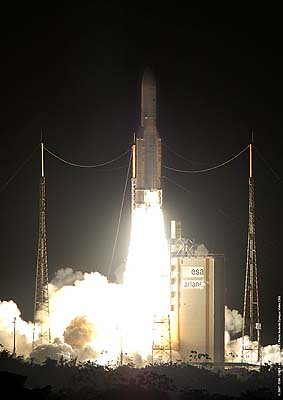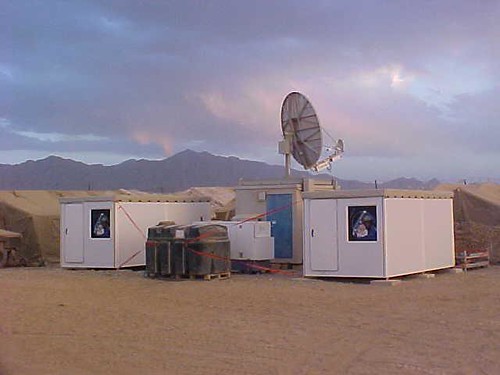Ariane 5 Payload Record

Ariancespace set a new record Wednesday evening:
Dans la nuit du mercredi 14 au jeudi 15 novembre 2007, Arianespace a mis en orbite de transfert géostationnaire deux charges utiles : le satellite de télécommunications militaires Skynet 5B d’Astrium Paradigm pour le Ministère britannique de la Défense et le satellite de télécommunications civiles Star One C1 de Thales Alenia Space pour l’opérateur brésilien Star One.
Trente-cinquième lancement d’Ariane 5, vingt-et-unième succès d’affilée et nouveau record de masse en orbite. Ce nouveau succès du lanceur Ariane 5, le cinquième en 2007, confirme que l’offre de Service & Solutions d’Arianespace est la référence pour tous les opérateurs du secteur des télécommunications civiles ou militaires. Depuis le début de 2007, Arianespace a lancé dix des douze satellites commerciaux de télécommunications lancés avec succès vers l’orbite géostationnaire.
Now, in English:
On Wednesday evening, November 14, Arianespace boosted two satellites into geostationary transfer orbit (GTO): the Astrium Paradigm Skynet 5B military communications satellite for the British Ministry of Defence (MoD), and the Star One C1 commercial communications satellite built by Thales Alenia Space for Brazilian operator Star One.
The latest successful launch of an Ariane 5, the fifth in 2007, confirms that Arianespace’s launch Service & Solutions continues to set the standard for all telecom operators worldwide, whether civil or military. Since the beginning of 2007, Arianespace has successfully launched 10 of the 12 commercial telecommunications satellites placed in geostationary orbit. The Ariane 5 ECA launcher set a new record on this mission, orbiting a total payload of more than 8,700 kg.>
This is very cool: a video shot from the jungles of French Guiana. So this is what’s its really like to be there.
The ESA explains what went on, rocket-wise:
The Ariane 5’s cryogenic, liquid fuelled, main engine was ignited first. Seven seconds later, the solid fuel rocket boosters were also fired, and a fraction of a second after that, the launch vehicle lifted off.
The solid boosters were jettisoned 2 min: 19 sec after main engine ignition, and the fairing protecting the payload during the climb through the Earth’s atmosphere was discarded at 3 min: 10 sec. The launcher’s main engine was shut down at 8 min: 58 sec; six seconds later the main cryogenic stage separated from the upper stage and its payload.
Four seconds after main stage separation, the engine of the launcher’s cryogenic upper stage was ignited to continue the journey. The upper stage engine was shut down at 24 min: 56 sec into the flight, at which point the launch vehicle was travelling at 9377 metres per second (just over 34 800 km/h) at an altitude of 626.1 kilometres and the conditions for geostationary transfer orbit injection had been achieved.
At 27 min: 12 sec after main engine ignition, Skynet 5B separated from the launcher, followed by Star One C1 at 33 min: 47 sec.
What about that payload?
The British Ministry of Defence (MOD) uses the Skynet satellites for communications, with this newest generation provided many times more capacity than the previous series. Interestingly, the MOD doesn’t really own the satellite. They contract with Paradigm Secure Communications to design, build and operate the entire Skynet system. They make sure it’s suitable for military use (hardened, jam-proof, etc.)

Star One C1’s X-band payload will be used by the Brazilian military, but most of the payload will be used for television broadcasting and Internet applicaitons. Representing the third generation of Embratel satllites, Star One C1 was built by Thales Alenia Space and is based on the Spacebus 3000B3 configuration. It will replace Brasilsat B2 at 65° West. The C-band beam will be pretty hot over Brazil, and will be available to commercial teleports in southern Florida, as will the Mercosur Ku-band beam. The Brazilian Ku-band beam will be concentrated over Brazil’s urban centers along the southeast coastal area.

We blogged about Intel helping establish the most remote WiMAX city in the world before, so we’re glad to see Embratel placing an emphasis on bridging the digital divide. The Embratel Institute is their dedicated organization, setting up communications points, digital libraries and distance learning programs throughout Brazil.

Hey, that reminds me. Have you done your part to help? The One Laptop Per Child project deserves your support.